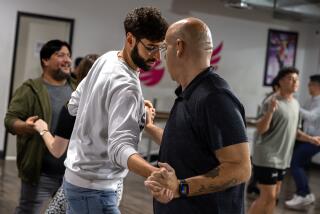MUSIC / DANCE : Folk Dancing Is Too an Art Form
- Share via
Folk dancing should get more respect, says Tibor Toghia, artistic director of the Karpatok Hungarian Folk Ensemble.
“There has been a misconception in this country that folk dancing is not an art form,” he says, “that it belongs in the gym with recreational dancers. It hasn’t been considered equal with jazz or ballet or modern dance. Those are the real arts in dancing. This is just recreational stuff. . . .
“I try to prove on stage that this is just as legitimate an art form as the others.”
He and his company will be making the case in a new show, “Traditions,” on Saturday at Orange Coast College.
The program, Toghia says, “not only represents the dances of Hungary as we know them today,” but also represents those dances and nationalities that are “currently not part of Hungary but still retain a Hungarian heritage--Romania, Yugoslavia and the border area of Russia.
“At one time, all these parts were part of Hungary and still maintain their Hungarian heritage and traditions,” he says. “We will also be showing some original Gypsy dances, which are not done a lot in this country.”
The company, celebrating its 25th season, was formed originally as “a meeting place for Hungarian youngsters and students” after the Hungarian 1956 revolution, Toghia says.
“A big influx of immigrants came over here then. They probably were having a little problem assimilating to the new culture they were living in. So a group of students decided it would be a good reason to get together a couple times of month, maintain ties together, some social functions and things like that. That’s how it originated.
“Only in the last 10 years has the company moved into what it is now--doing our own research, choreographies and even doing things that aren’t being danced in Hungary.”
The company operates on a budget of about $80,000, derived from the California Arts Council, the city of Los Angeles and various state touring programs.
“Box office plays a very little part,” Toghia says.
Nor does his job as artistic director pay his bills. “I have an import company in Northridge,” he says.
Born in Hungary, Toghia was one of the 1956 immigrants, coming to this country when he was 3. He returns to his native land to do research for the company.
“Almost all villages have some real dance styling of their own,” he says. “Hungary is one of the only countries in that part of the world where line dances took secondary importance. There is much more couple dancing than line, and much more individual dancing than couple dancing. . . .
“But you can’t take the whole village and put it on the stage. A lot of that dancing is very repetitive. A wedding festival would go on for three days sometimes.
“What I would try to do is take the things that are most relevant, most significant, within a certain festival and condense it.
“Obviously, a choreographer is a very narrow camera lens. The problem is, if you don’t do it right, you’ve already taken it out of context, so you could confuse people more than enlighten them. That’s the real challenge to put folk dancing on stage.”
What: Karpatok Hungarian Folk Ensemble.
When: Saturday, Jan. 26, at 8 p.m.
Where: Robert B. Moore Theatre at Orange Coast College, 2701 Fairview Road, Costa Mesa.
Whereabouts: San Diego Freeway to the Fairview exit; south to Orange Coast College.
Wherewithal: $8.50 advance purchase; $10 at the door.
Where to Call: (714) 432-5880.
More to Read
Sign up for Essential California
The most important California stories and recommendations in your inbox every morning.
You may occasionally receive promotional content from the Los Angeles Times.













